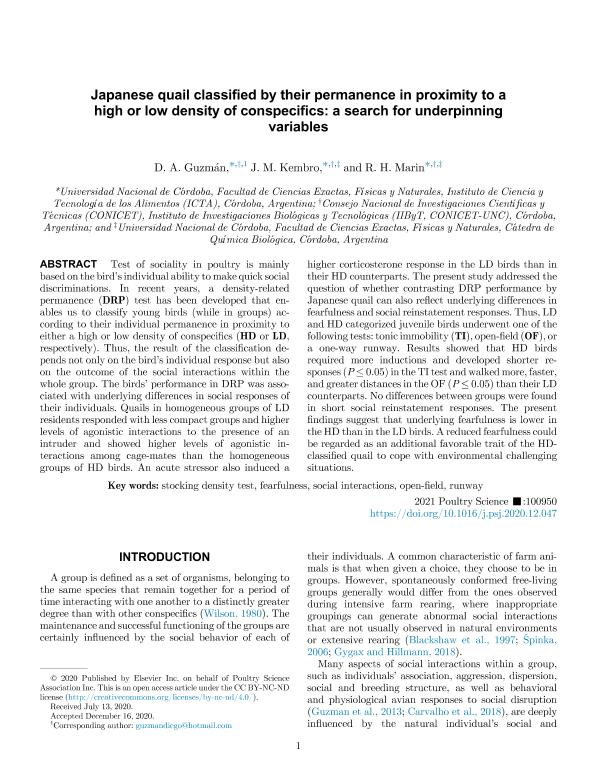Artículo
Japanese quail classified by their permanence in proximity to a high or low density of conspecifics: a search for underpinning variables
Fecha de publicación:
03/2021
Editorial:
Poultry Science Association
Revista:
Poultry Science
ISSN:
0032-5791
e-ISSN:
1525-3171
Idioma:
Inglés
Tipo de recurso:
Artículo publicado
Clasificación temática:
Resumen
Test of sociality in poultry is mainly based on the bird's individual ability to make quick social discriminations. In recent years, a density-related permanence (DRP) test has been developed that enables us to classify young birds (while in groups) according to their individual permanence in proximity to either a high or low density of conspecifics (HD or LD, respectively). Thus, the result of the classification depends not only on the bird's individual response but also on the outcome of the social interactions within the whole group. The birds' performance in DRP was associated with underlying differences in social responses of their individuals. Quails in homogeneous groups of LD residents responded with less compact groups and higher levels of agonistic interactions to the presence of an intruder and showed higher levels of agonistic interactions among cage-mates than the homogeneous groups of HD birds. An acute stressor also induced a higher corticosterone response in the LD birds than in their HD counterparts. The present study addressed the question of whether contrasting DRP performance by Japanese quail can also reflect underlying differences in fearfulness and social reinstatement responses. Thus, LD and HD categorized juvenile birds underwent one of the following tests: tonic immobility (TI), open-field (OF), or a one-way runway. Results showed that HD birds required more inductions and developed shorter responses (P ≤ 0.05) in the TI test and walked more, faster, and greater distances in the OF (P ≤ 0.05) than their LD counterparts. No differences between groups were found in short social reinstatement responses. The present findings suggest that underlying fearfulness is lower in the HD than in the LD birds. A reduced fearfulness could be regarded as an additional favorable trait of the HD-classified quail to cope with environmental challenging situations.
Palabras clave:
STOCKING DENSITY TEST
,
FEARFULNESS
,
SOCIAL INTERACTIONS
,
OPEN-FIELD
,
RUNWAY
Archivos asociados
Licencia
Identificadores
Colecciones
Articulos(IIBYT)
Articulos de INSTITUTO DE INVESTIGACIONES BIOLOGICAS Y TECNOLOGICAS
Articulos de INSTITUTO DE INVESTIGACIONES BIOLOGICAS Y TECNOLOGICAS
Citación
Guzmán, Diego Alberto; Kembro, Jackelyn Melissa; Marin, Raul Hector; Japanese quail classified by their permanence in proximity to a high or low density of conspecifics: a search for underpinning variables; Poultry Science Association; Poultry Science; 100; 3; 3-2021; 1-10; 100950
Compartir
Altmétricas




